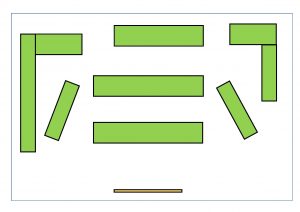Part 1 -Talk Partners & Seating

In a world where knowledge and excellence are increasingly shared, we understand the importance of discussion and learning from others. “Talk Partners” is a term we use to refer to pupils discussing and planning together and cooperatively improving each other’s learning.
On the advice of Shirley Clarke, I’ve recently implemented the changing of Talk Partners much more frequently and rearranged the seating plan in the class to enable classroom talk to be more effective and focused.
What we did:

- Mixed ability seating had already been standard practice in our class, arranged with tables grouped into six/eight children. The upside of this is that it lends itself naturally to group work. The downside is that some children were always facing away from the front, and had to keep moving their chairs round or worse, twisting their backs, every time they were required to face the front of the class. We have now rearranged the seating into a broadly U-shape, with rows in between (within classroom shape limitations!) The upside of this is that all children are now facing the front but also have a talk partner beside them. When we want to work in a group, the pupils have worked out for themselves that it is a very quick task to move their tables together.
- Talk partners are now changed much more frequently (weekly), using the random lollipop method, in order to maximise the experience of learning from so many of their peers. Over the course of the remaining year, each child will have had the opportunity to have been paired with over half the class. Next year, this will increase as we begin this from the start of September.
Outcomes
Talk partners allow children a chance to articulate and rehearse their thinking before sharing with the whole class. The experience of having different learning partners has already benefited the pupils in many ways across the curriculum in our class, and is removing the inevitability of some children not wanting to work with other children (such as across the 5-6 Year divide, or girl/boy pairing). Pupils are beginning to recognise and value the skills of others (e.g. such as who has a talent for ICT or our current topic etc..) and they remember those skills at a later date.
The higher achievers have benefited by being “explainers”, a higher order skill which deepens and embeds their own learning. The lower achievers have benefited from discussing ideas from a perspective other than mine! They have all begun to recognise that all children have ideas and talents and that each brings different strengths to the partnership and this has increased the respect they have for each other.
The pupils liked the new seating arrangements much more than I had anticipated, “off task” talk has all but disappeared and the children have taken to the frequent change in talk partners in a very positive manner. Some have even spoken to another member of the class for the first time!
To Follow:- Part 2 – Achieving Effective Talk – how we have maximised the learning opportunities with the Talk Partner strategy.
